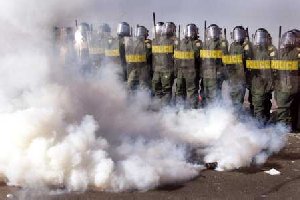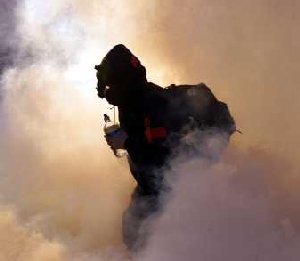
 |
The effects from riot control agents are usually self-limiting, and medical attention is usually not required. Exiting the contaminated area should bring some measure of relief in 15 to 30 minutes or sooner. In rare circumstances, complications may occur on the skin, in the eyes, or in the airways.
The use of water on the skin may result in transient worsening of the burning sensation. Soap and water may be more effective but may also cause a momentary increase in the symptoms. CS rapidly hydrolyzes in an alkaline solution; a solution containing 6% sodium bicarbonate, 3% sodium carbonate, and 1% benzalkonium chloride was found to bring prompt relief of symptoms and to hydrolyze the agent. No form of hypochlorite should be used.
 |
For dermatitis, a topical steroid preparation (eg, triamcinolone acetonide, fluocinolone acetonide, flurandrenolone, or betamethasone-17-valerate) is the principal therapeutic agent. Oozing lesions should be treated with wet dressings (moistened with fluids such as 1:40 Burow's solution). Appropriate antibiotics should be given for secondary infection, and oral antihistamines for itching. Vesicating lesions have been successfully treated with compresses of a cold silver nitrate solution (1:1,000) for 1 hour, applied six times daily. One person with severe lesions and marked discomfort was given a short course of an oral steroid. An antibiotic ointment was applied locally, but systemic antibiotics were not used.
A local anesthetic might be applied once for severe pain, but continued use should be restricted. The eye should be thoroughly flushed to remove any particles of the agent. If the lesion is severe, the patient should be sent to an ophthalmologist.
Usually, the cough, chest discomfort, and mild dyspnea are gone 30 minutes after exposure to clean air. However, both the animal data (detailed in the section on CS) and the clinical experience with the infant exposed to CS suggest that severe respiratory effects may not become manifest until 12 to 24 hours after exposure. An individual who has prolonged dyspnea or objective signs should be hospitalized under careful observation. Further care should be as described in Chapter 9 (http://ccc.apgea.army.mil/Documents/HTML_Restricted/chapters/Chapter_9.htm), Toxic Inhalational Injury. Although people with chronic bronchitis have been exposed to riot control agents without untoward effects, any underlying lung disease (eg, asthma, which affects one person in six in the general, or the military, population) might be exacerbated by exposure to CS.
Transient hypertension has been noted after exposure to riot control agents, primarily because of the anxiety or pain of exposure rather than a pharmacological effect of the compound. Whatever the cause, adverse effects may be seen in individuals with hypertension, cardiovascular disease, or an aneurysm.
Full report on riot control agents at:
http://ccc.apgea.army.mil/Documents/HTML_Restricted/chapters/chapter_12.htm